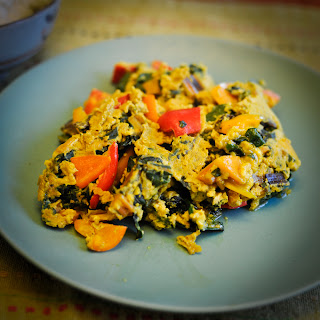I used to know only one way to eat cauliflower: baked cauliflower with cheesy white sauce. I did not like it very much, so I rarely ate cauliflower. However, since I learned about the high nutritional value of cauliflower, I have been trying out different recipes. This cauliflower and potato stir-fly is called "aloo gobhi sabzi" by Indian people. It is simple but flavorful with spices.
When brown rice is germinated (called "
hatsuga genmai" in Japanese), it is tastier (because starch and protein are converted into sugar and "
umami"), easier for our bodies to digest (because the hard cell gets broken, and
phytic acid is reduced), and more nutritious (because some nutrients, including
GABA, increase in amount or become more readily available to our bodies, and additional nutrients are developed). Azuki beans help to activate even more enzymes in this rice dish called "hatsuga koso genmai (germinated enzyme-enriched brown rice)," one of the nutritionally near-perfect foods about which Japanese people rave.
Cauliflower and potato sabzi
Ingredient (for 6 servings):
1 head of cauliflower
2 medium-size or 3 small-size potatoes
1 small-size onion
2 TBSP of fresh ginger
2 cloves of garlic
1 tsp of tarmelic
1 tsp of cumin
1/2 tsp of cayenne pepper
Directions:
1. Grate ginger and garlic and chop onion finely.
2. Heat oil in a frying pan and stir-fry #1 until onion looks transparent.
3. Wash and cut potatoes and cauliflower into small cubes/florets.
4. Add potato cubes in the pan and stir-fry and steam-cook them with a lid until they are almost fully cooked.
5. Add cauliflower florets in the pan and stir-fry and steam-cook them with a lid until they are almost fully cooked. (By this time, potatoes should be golden brown and soft.)
6. Add all seasonings in the pan, mix everything well, and continue to cook until cauliflower is done.
*
Ghee is tasty and is often used for Indian dishes, but coconut oil (organic, extra virgin, and cold-pressed) is the healthiest when being cooked in high heat. Olive oil (organic, extra virgin, and cold-pressed) loses its health benefits when being cooked in high heat, so it is better saved for salad dressing, drizzling over pasta, or dipping bread in.
Here is a great fat debate online, if you are interested.
Germinated brown rice with azuki beans
Ingredients (for 6 servings):
3 cups of brown rice (preferably organic)
1/2 cup of
azuki beans (preferably organic)
Filtered water
Need a strainer, a large bowl, a whisk, and a rice cooker.
Directions (to serve for supper next day):
1. On the previous night, quickly rinse brown rice and azuki beans in running water (If not organic, wash them more thoroughly).
2. Put the rice and beans in a large bowl, and add filtered water until the rice and beans are submerged in water.
3. With a whisk, beat the rice and beans slowly for several minutes until the water gets cloudy.
4. Boil a cup of filtered water and add it slowly to the bowl until the water in the bowl gets lukewarm. Soak the rice and beans in lukewarm filtered water for 24 hours (Lukewarm water accelerates their germination processes).
5. Drain and air-dry the rice and beans for a while. (Just leave them wet in bowl for several hours, which further facilitates their germination processes. You do not see them sprouting, but the germ of brown rice may look more plump and white, and azuki beans should also look more plump and lighter in color.)
6. Put the germinated rice and azuki beans in a rice cooker, pour filtered water up to the water measurement line for 4 cups of rice, and start cooking.
7. After the cooking time is up, keep the lid on for 15 more minutes for some steaming effect. After 15 minutes, open the lid and stir up the cooked germinated brown rice with azuki beans well, and put the lid back and keep it warm until it is served.*
*Some people suggest that the longer you let this germinated brown rice with azuki beans rest in a keep-warm setting, the more enzymes it develops (because it begins to ferment) and the tastier it gets. I am not sure about the biochemistry of enzymes, but in my experience, it tasted best after being kept warm no longer than an hour or so.












